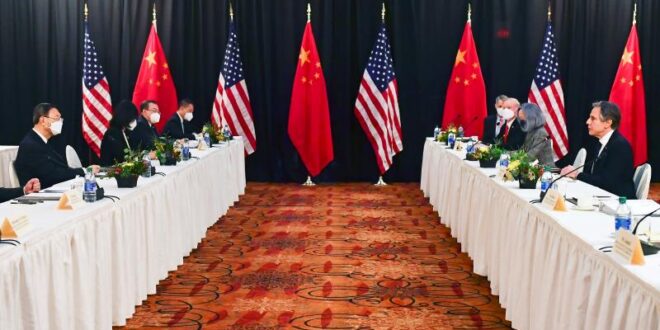To Counter Beijing, the Biden Administration Needs to Decide What It Wants
The Biden administration has repeatedly identified China as the United States’ foremost foreign policy challenge. Secretary of Defense Lloyd Austin has referred to China as the Pentagon’s top priority. Secretary of State Antony Blinken has described China as “the biggest geopolitical test” of the twenty-first century. And President Joe Biden himself has stated that he envisions “extreme competition” between Washington and Beijing. As his administration prepares to issue a raft of strategy documents—including for national security, national defense, and the Indo-Pacific—it is widely expected to single out China for special attention.
To invoke the U.S.-Chinese rivalry as a defining feature of today’s world is now commonplace, and analysts and policymakers across the political spectrum support the United States’ shift away from engagement and toward competition. Jettisoning Washington’s previous strategy of cooperation and integration, premised as it was on the eventual transformation of Chinese behavior, is a rare point of agreement between the Trump and Biden administrations.
That is a welcome shift, given the paucity of positive results yielded by the previous approach. China and the United States are in a largely competitive relationship, and U.S. policy aims to respond to Chinese actions more than to shape them. A strategy grounded in this reality—one that combines a U.S.-led coalition with targeted, issue-specific efforts to contest Chinese assertiveness—is now emerging to protect U.S. interests and values.
There is, however, a glaring omission in the new policy: an objective. Competition is merely a description of U.S.-Chinese relations, not an end in itself. Conspicuously absent from the flurry of recent pronouncements is the endgame that Washington ultimately seeks with China. Without a clearly defined goal, any overarching strategy is likely to waste resources, frustrate attempts to track progress, and elude the broad-based domestic support necessary to sustain it. U.S. allies and partners wish—and deserve—to know the objective of the coalitions in which Washington increasingly seeks to enlist them. The absence of a clear goal for its self-proclaimed top priority is a liability for the Biden administration—and one that it should urgently work to address.
EYES ON THE PRIZE
Good strategies articulate a desired end state and outline how to attain it. In his famous 1947 Foreign Affairs article, for instance, the diplomat and historian George Kennan argued for “either the breakup or the gradual mellowing of Soviet power,” to be pursued through a policy of containment and an effort to increase the strains under which the Soviets operated. Establishing such an objective, as the United States did early in the Cold War, explicitly ruled out other possible goals, such as a partnership and political intimacy between Washington and Moscow on the one hand or the active rollback of communism on the other. Having identified the collapse or moderation of Moscow’s regime as their aim, U.S. officials pursued containment as the strategy most likely to yield those positive results.
After the end of the Cold War, the United States established a set of objectives for China and theorized about how to achieve them. In 1997, U.S. President Bill Clinton said that Washington’s goal vis-à-vis Beijing “is not containment and conflict; it is cooperation,” noting that “a pragmatic policy of engagement” was most likely to bring that about. By engaging Beijing, primarily but not exclusively through trade, the Clinton administration aimed to cultivate a “stable, open, and non-aggressive” China. U.S. policymakers postulated that such openness might even foster liberalization and political pluralism within China itself.
The George W. Bush administration largely retained the goal of a cooperative and liberalizing China, adding to it a wish that the country would become a “responsible stakeholder” in the international system. Washington would seek areas of active cooperation with Beijing across the spectrum of global challenges from terrorism to energy conservation in hopes that Chinese leaders would become invested and active in addressing them. Perhaps less certain than its predecessor in the prospects for cooperation, the Bush administration hedged its bets by boosting U.S. military capabilities and bolstering alliances and partnerships throughout Asia.
Competition is merely a description of U.S.-Chinese relations, not an end in itself.
The Obama administration shared many of the Bush administration’s objectives, but it hedged even more heavily as doubts about Beijing’s direction and goals grew. Still, Secretary of State Hillary Clinton rejected the notion of an adversarial Beijing, saying that it was “essential” for the United States and China to have “a positive, cooperative relationship.” The administration announced a “pivot” or “rebalance” to Asia aimed at forging such a relationship by embedding it in a “regional framework of security alliances, economic networks, and social connections” that would strengthen the United States’ position.
President Donald Trump ushered in a new era of U.S.-Chinese relations. His administration neither sought a cooperative relationship with Beijing nor pursued engagement as a central means of securing U.S. interests. Rejecting the notion that integration into the global order would spur either Chinese liberalization or responsible international behavior, the Trump administration labeled Beijing a “revisionist power” with which the United States would have a fundamentally competitive relationship. Trump’s Indo-Pacific strategy, declassified in the waning days of his presidency, takes malign Chinese activity as a given to be resisted, often in concert with partners. The Trump administration was no model of message discipline, however, and key policymakers differed on the desired end state. Whereas Trump predicted in 2020 that his bilateral trade deal would “bring both the U.S. and China closer together in so many other ways,” Secretary of State Mike Pompeo announced that same year that the United States “must induce China to change” and suggested that efforts to replace the regime in Beijing might be on the table.
To be sure, any brief review of the past several administrations’ China policies risks attributing a coherence and continuity to their strategies that did not always exist. Governments are not unitary actors, objectives and approaches change with shifting circumstances and players, and public pronouncements can conflict with private aims. Yet for much of the time since the end of the Cold War and, particularly, during the years of U.S. engagement with China, Washington’s objectives with regard to Beijing were generally explicit. That is simply not the case today.
FROM THE BOTTOM UP
The fate of the U.S.-Chinese relationship has profound global implications, and so the objective of U.S. policy should flow from the kind of order Washington wishes to obtain—and the kind of threat China poses to that order. The United States generally seeks to maintain a global order governed by rules rather than by brute power, one in which countries enjoy sovereignty, disputes are resolved peacefully, markets are open to trade, human rights are considered universal, and democracy can flourish. Although the United States’ own track record in upholding such principles is hardly perfect, the country has nevertheless championed them as ideals that should govern international behavior. Since the 1940s, Washington has opposed hostile spheres of influence emerging in Eurasia precisely because they threaten the United States’ desired rules-based order. The overarching goal of U.S. policy today should be to preserve the core pillars of the international order, even as specific rules and institutions change and adapt.
From that overarching goal should flow the objective of U.S. policy toward China. Given China’s growing military and technological power, its assertive behavior, its economic interdependence with the United States and its allies, and the incompatibility of many Chinese actions with the existing order, it is past time for Washington to articulate an objective that is both realistic and protective of its people. The aim of U.S. policy toward China should be to ensure that Beijing is either unwilling or unable to overturn the regional and global order.
China might cease trying to overturn elements of the liberal order if its leaders come to see the strength of the countries that are committed to them and the vigor with which they oppose China’s efforts to disrupt them. Beijing might someday even see its own future in the preservation of the liberal order. And even if it does not, it could grow incapable of undermining the order for any number of reasons: due to Beijing’s own weaknesses, the unpalatability of its authoritarian vision in other countries, or a relative strengthening of the powers committed to the liberal status quo.
The objective of U.S. policy should flow from the kind of order Washington wishes to obtain.
A China that is unwilling or unable to undermine the regional and global order is a fairly abstract goal for U.S. policy, but it would nonetheless rule out several other potential objectives. Washington would not aim to transform China into a liberal power or a responsible stakeholder in the international system. Washington would not work toward Cold War–style containment or regime change in Beijing. And it would not aim to stop China’s rise but rather oppose Beijing’s efforts to disrupt existing international arrangements in ways that damage the United States and its partners.
Progress toward this objective would almost certainly be a matter of degree, but it could be measured (unlike progress toward the broad notion of competition). China’s approach to global rules and norms is varied, however. Beijing does not seek to simply repeal and replace what currently exists but rather to reject some principles, accept others, and rewrite the remainder. Such subtlety should help define U.S. priorities, as Washington should focus on preserving those elements of the liberal order that are simultaneously of greatest importance to U.S. interests and under the most threat from Chinese behavior.
A new medium-term policy agenda would naturally flow from such a goal: the United States would seek to improve its military position in the Indo-Pacific relative to China; contest China’s use of economic coercion, including through an ambitious regional trade policy that aims to reduce countries’ reliance on the Chinese market; build new technology partnerships to ensure the free flow of information; and focus existing alliances on protecting democracies from external interference. Washington would, in other words, continue many of the efforts that currently fall under the broad umbrella of competition, but it would channel them toward resisting Chinese attempts to upend key elements of the liberal order.
All of this would entail a shift in how the Biden administration communicates—and thinks about—its China policy. The United States would not strictly be competing against China but would rather be working toward the preservation and extension of core international values that serve many other nations well. U.S. partners would not be required to break their ties with China in order to join a unified bloc, but they would be encouraged to join coalitions aimed at resisting Beijing on specific issues, such as economic coercion, military aggression, the spread of illiberal technologies, and human rights abuses. The accompanying message, despite Beijing’s claims to the contrary, would be that Washington does not seek to suppress China’s rise but rather to establish a U.S.-Chinese equilibrium in the long term.
RECKONING DAY
The United States and the world can live with a powerful China that does not attempt to overturn key principles of the liberal order. At the moment, however, that possibility seems remote. The military balance in the Indo-Pacific is shifting away from the United States and its allies and toward Beijing. China is becoming increasingly economically dominant in Asia, with Washington absent from any real leadership on trade. Chinese diplomacy is growing more coercive and more focused on the internal affairs of other countries, undermining their sovereignty and independence. Although cooperation with Beijing is desirable and theoretically possible, it is in very short supply, even in areas in which U.S. and Chinese interests seem to overlap, such as climate change and pandemic disease. The overall picture is quite appealing to Beijing: a steadily eroding U.S. role in the Indo-Pacific and beyond, accompanied by a steadily growing Chinese presence.
Reversing that trend is no easy task. It will take years and involve risks. Diplomacy can help mitigate these risks, but only to a limited degree; the United States will need to accept increased tension in the medium term in order to achieve a more stable equilibrium with China in the long term.
Every month, it seems, U.S. policymakers sound the alarm about the U.S.-Chinese relationship with greater volume. Across party lines and branches of government, many policymakers now endorse a major response to the China challenge. The watchwords are more resources, more speed, more vigor. All of this is appropriate. But Washington would do well to clarify what, precisely, this national effort aims to achieve.
 Eurasia Press & News
Eurasia Press & News




